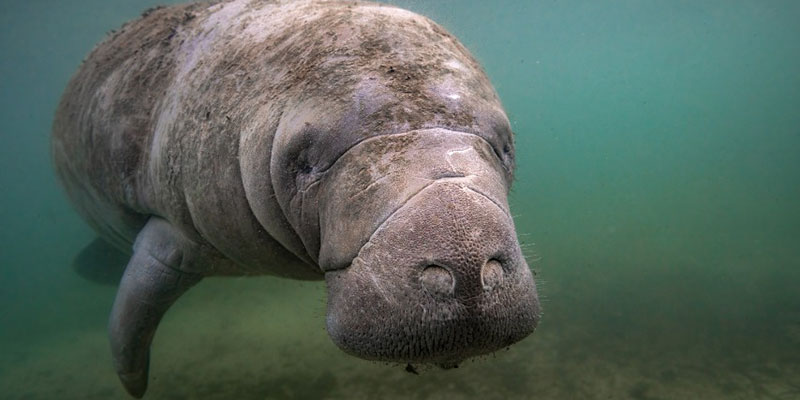Nutrient overloads from runoff are feeding algae blooms that degrade water quality and kill the seagrass Florida manatees need.
With septic tank leakage at crisis levels, proper wastewater treatment can improve the beloved mammals’ habitat
The manatee inspires affection from those who watch the gentle aquatic mammals feed on seagrass in Florida’s waterways. Sadly, manatees are dying in record numbers. New legal action, however, along with septic-to-sewer programs, could help save the creatures.
More than 1,000 manatees died in Florida in 2021, about 10% of the population. It was a disheartening new record, and the trend has continued into 2022, with 562 deaths recorded through May. Manatees on the west coast of Florida are unaffected, but in the Indian River Lagoon on the east coast, they are starving to death. The lagoon is home to a third of the population of manatees in the United States, and 30% of the deaths were reported there.
Nutrient overloads from fertilizer-laden agricultural runoff and inadequate septic systems are fueling harmful algal blooms that degrade water quality and kill the seagrass manatees need.
Legal Action Forces Habitat Cleanup
In 2008, the Center for Biological Diversity, Defenders of Wildlife, and the Save the Manatee Club petitioned the U.S. Fish and Wildlife Service (FWS) to update 1976 manatee protections. The effort was unsuccessful, so the organizations filed suit in early 2022. The resulting settlement requires the FWS to propose revisions to manatee habitat protections by September 2024. The organizations also joined forces with Earthjustice to put more pressure on the Environmental Protection Agency to act.
Addressing Causes of the Problem
To save the manatees, one problem Florida will have to address is nutrient contamination that kills seagrass and causes algal blooms. Duane DeFreese, executive director of the Indian River Lagoon Council, said, “I think the public tolerance for having algal blooms and dirty water is gone.”
One of the main issues is septic tanks.
Septic tanks have become a growing problem statewide, partly because sea-level rise and increased precipitation raise water tables too close to septic system drain fields. Rachel Silverstein, executive director of Miami Waterkeeper, said that every year, 56% of septic tanks malfunction for a certain amount of time. “That’s a huge deal for a developed country … to have half of the septic tanks not functioning for part of the year,” she said. When these systems malfunction, the sewage escapes into groundwater and eventually into surface water bodies, killing seagrass, resulting in algal blooms.
Converting septic systems to tie-ins with sewer systems has been helpful in protecting seagrass from nutrient overloads in other parts of the state. Tampa Bay, for instance, constructed more sewers and updated wastewater treatment facilities in the 1970s, leading to a robust recovery of seagrass.
The American Society of Civil Engineers has estimated that Florida will have to spend $18 billion to fix the state’s wastewater infrastructure. Dr. Brian Lapointe, research professor at Florida Atlantic University, warned, “Florida is at a tipping point. The fight against algae is the fight for Florida’s future.”
Wastewater Treatment’s Role
While large, central plants have been the dominant mode of wastewater treatment in Florida, a newer model of treatment — decentralization — uses smaller plants and shorter pipelines, which can make the switch from septic to sewer more cost-efficient and effective.
Some newer modular wastewater treatment units use more effective processes, such as the membrane aerated biofilm reactors (MABRs) in Fluence’s Aspiral™ units, which have exceptional nutrient removal performance and energy efficiency. Aspiral™ also can be applied for nutrient removal where agricultural runoff is channeled into drainage tile or ditches.
With nutrient overloads and resulting algal blooms causing public health problems, the interests of Floridians and their beloved aquatic mammal neighbors seem to be aligning. Contact Fluence for a more efficient transition from septic to sewer.

